Forex Trading: A Guide to Success and Risk Management
Unlock the secrets to Forex trading success! Learn proven strategies for consistent profitability and avoid common pitfalls. Master the market and achieve your financial goals. Conquer Forex today!

The allure of Forex trading is undeniable. The promise of quick riches, the potential for high returns, and the accessibility of the market draw countless individuals in. However, the reality is far more nuanced. While some traders achieve remarkable success, many others experience significant losses. The question, therefore, is not whether *anyone* can make money, but rather, under what conditions and with what strategies can consistent profitability be achieved? This article delves into the complexities of Forex trading, exploring the factors that contribute to success and the pitfalls that lead to failure.
Understanding the Forex Market: A Complex Ecosystem
The foreign exchange market (Forex or FX) is the world’s largest and most liquid financial market, operating 24 hours a day, five days a week. It involves the trading of currencies in pairs, such as EUR/USD (Euro/US Dollar) or GBP/JPY (British Pound/Japanese Yen). Unlike stock markets with centralized exchanges, Forex trading occurs over-the-counter (OTC), meaning transactions take place directly between two parties, typically through brokers. This decentralized nature contributes to the market’s high liquidity but also introduces complexities regarding regulation and transparency.
Leverage: A Double-Edged Sword
One of the defining characteristics of Forex trading is the use of leverage. Leverage allows traders to control a larger position than their initial capital would normally allow. For example, a 1:100 leverage allows a trader to control $100,000 with only $1,000 of their own money. While leverage amplifies potential profits, it also dramatically magnifies potential losses. A small market movement against a highly leveraged position can quickly wipe out a trader’s entire account, a phenomenon known as “margin call”.
Technical Analysis vs. Fundamental Analysis
Successful Forex trading often involves a combination of technical and fundamental analysis. Technical analysis focuses on historical price charts and patterns to predict future price movements. Traders use various indicators and tools to identify potential trading opportunities. Fundamental analysis, on the other hand, considers macroeconomic factors, such as interest rates, inflation, and political events, that can influence currency values. A comprehensive understanding of both approaches is crucial for making informed trading decisions.
The Role of Education and Risk Management
The path to successful Forex trading begins with education. Aspiring traders should dedicate time to learning about market mechanics, trading strategies, risk management techniques, and fundamental and technical analysis. This education shouldn’t be limited to online courses; practical experience through demo accounts and meticulous record-keeping are essential. It’s crucial to avoid get-rich-quick schemes and unrealistic promises often found in online advertisements.
Developing a Robust Trading Plan
A well-defined trading plan is the cornerstone of successful Forex trading. It should outline your trading strategy, risk tolerance, position sizing, and entry and exit points. Sticking to your plan, even during periods of market volatility, is crucial for emotional discipline and consistent performance. Regularly reviewing and adjusting your plan based on market conditions and your performance is equally important.
Effective Risk Management Strategies
Effective risk management is paramount in Forex trading. This involves setting stop-loss orders to limit potential losses on each trade and using appropriate position sizing to prevent a single losing trade from significantly impacting your account. Diversification across different currency pairs can also help reduce overall risk. Never invest more than you can afford to lose.
- Set realistic profit targets: Don’t aim for unrealistic gains in each trade.
- Use stop-loss orders consistently: Protect your capital from significant losses.
- Diversify your portfolio: Don’t put all your eggs in one basket.
- Regularly review your performance: Identify areas for improvement.
The Psychological Aspect of Forex Trading
Trading Forex successfully involves more than just technical and fundamental analysis. The psychological aspect is often overlooked but is critical for long-term success. Emotions such as fear, greed, and hope can cloud judgment and lead to impulsive decisions. Developing emotional discipline is key to avoiding emotional trading pitfalls.
Overcoming Emotional Biases
Traders often fall prey to cognitive biases that can negatively impact their trading decisions. Confirmation bias, for example, leads traders to seek out information that confirms their existing beliefs, while anchoring bias makes them overly reliant on initial information. Recognizing and mitigating these biases is essential for objective decision-making.
The Importance of Patience and Discipline
Forex trading requires patience and discipline. Not every trade will be profitable, and periods of drawdown are inevitable. Successful traders understand this and avoid impulsive reactions to short-term market fluctuations. They stick to their trading plan and maintain a long-term perspective.
Choosing the Right Broker and Platform
Selecting a reputable and regulated Forex broker is vital. A reliable broker offers competitive spreads, robust security measures, and excellent customer support. Research different brokers, compare their fees and services, and choose one that aligns with your trading style and needs. The trading platform itself should be user-friendly, providing access to essential tools and charting capabilities.
Understanding Broker Fees and Spreads
Brokers earn money through spreads (the difference between the bid and ask price) and commissions. Understanding these fees is crucial for calculating your trading costs. Compare spreads across different brokers to ensure you are getting competitive pricing. Hidden fees and commissions should be avoided.
Security and Regulation
Ensure your chosen broker is regulated by a reputable financial authority. Regulation provides a level of protection for traders, ensuring that the broker adheres to certain standards and practices. Check the broker’s security measures to ensure your funds are safe and protected against fraud.
Real-World Examples and Case Studies
While specific examples of individual trader success are confidential and vary widely, we can examine general strategies. For instance, a successful long-term trader might focus on identifying major economic trends using fundamental analysis and employing a long-term investment strategy; They’d be patient, accepting periods of stagnation to capitalize on larger movements. Conversely, a day trader might rely heavily on technical analysis and short-term price fluctuations, aiming for small, consistent profits throughout the day. The key takeaway is that successful strategies vary greatly depending on individual risk tolerance, time commitment, and trading style.
- Scalping: Short-term trading focusing on small price movements.
- Swing Trading: Holding positions for several days or weeks.
- Position Trading: Holding positions for months or even years.
- Day Trading: Closing all positions before the market closes.
Remember, past performance is not indicative of future results. While studying successful trader profiles can be insightful, it’s crucial to develop your own unique strategy based on your skills and risk appetite. Avoid blindly copying others; instead, learn from their approaches and adapt them to your own circumstances.
Forex trading is a challenging but potentially rewarding endeavor. Success requires a combination of education, discipline, risk management, and a deep understanding of market dynamics. While anyone can *try* to make money trading Forex, only those who are prepared to dedicate the necessary time, effort, and resources are likely to achieve consistent profitability. Remember that losses are an inherent part of trading; learning from them is essential for growth. Continuous learning and adaptation are key to navigating the complexities of the Forex market and ultimately achieving your financial goals. The journey to mastering Forex trading is a marathon, not a sprint. Consistent effort and a well-defined plan are crucial for long-term success. By understanding the realities of Forex trading and implementing effective strategies, you can significantly increase your chances of achieving your financial aspirations.







